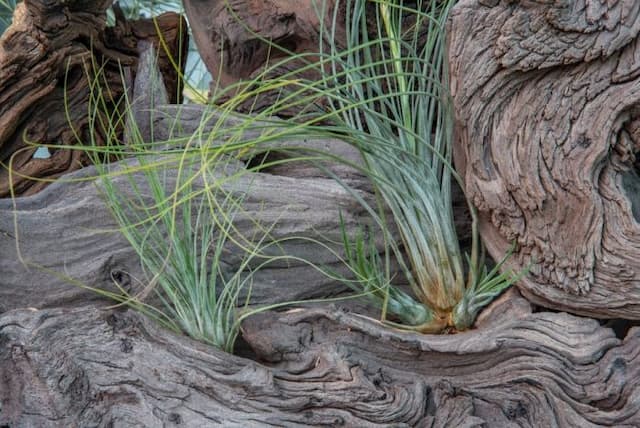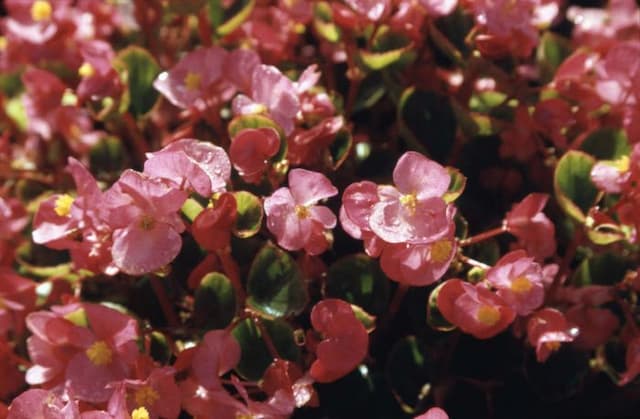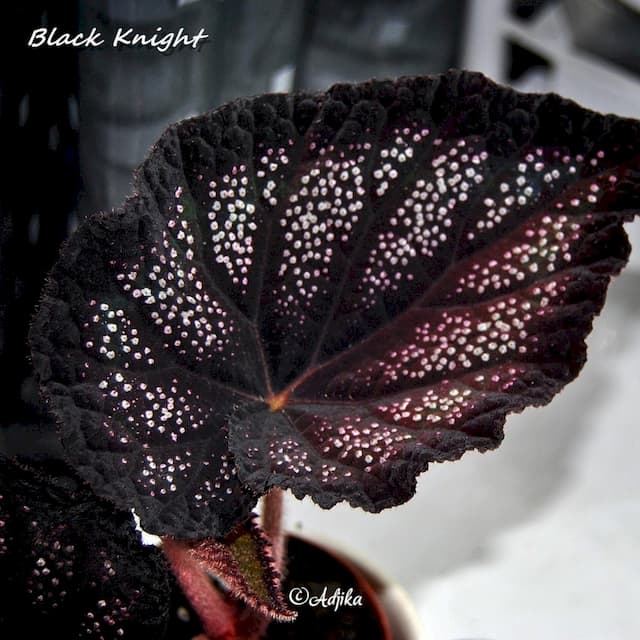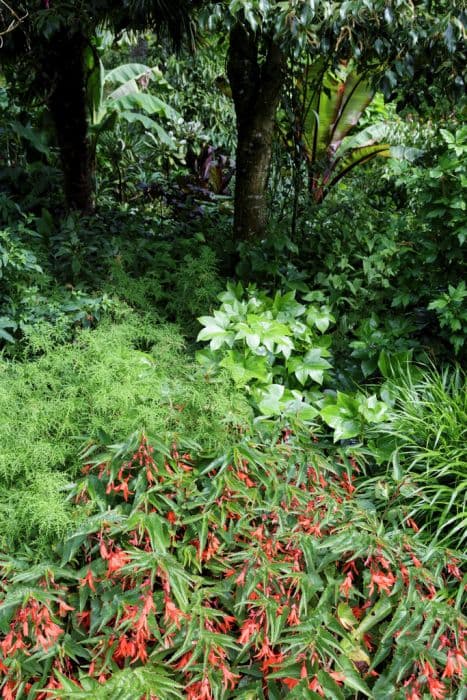Gryphon Begonia Begonia 'Gryphon'

ABOUT
Begonia 'Gryphon' showcases striking foliage that instantly catches the eye due to its unique appearance. The leaves are large, with a bold texture that gives the plant a lush, full look. The color of the foliage is predominantly a deep green but is enlivened by a silver overlay that imparts a metallic sheen. This silvery effect highlights the intricate patterns and vein structure on the leaves, creating an almost sculptural quality. The leaf edges typically exhibit a subtle scalloping, which further accentuates the plant's ornamental appeal. Adding contrast to the foliage are the undersides of the leaves, which are often a reddish color, that provides an interesting visual when the leaves are viewed from different angles. Begonia 'Gryphon' has a robust and upright habit, with sturdy stems that support the heavy foliage. While the plant does bloom, its flowers are generally considered less significant than the spectacular leaves, which are the main reason gardeners and indoor plant enthusiasts cherish this variety. The blooms, when they appear, tend to be small and may range in color from white to soft pink. Overall, Begonia 'Gryphon' is a showy plant primarily grown for its decorative leaves that can add a touch of elegance and drama to both garden beds and indoor settings.
About this plant
 Names
NamesFamily
Begoniaceae
Synonyms
Gryphon Begonia
Common names
Begonia 'Gryphon'
 Toxicity
ToxicityTo humans
Begonia 'Gryphon' is considered non-toxic to humans. However, eating any part of the plant is not advised as it can cause mild irritation in the mouth or throat due to the presence of insoluble oxalates.
To pets
Begonia 'Gryphon' is toxic to pets, especially dogs and cats. If ingested, it can cause symptoms such as irritation of the mouth, tongue, and lips, excessive drooling, vomiting, and difficulty swallowing due to the presence of insoluble oxalates.
 Characteristics
CharacteristicsLife cycle
Perennials
Foliage type
Evergreen
Color of leaves
Mixed
Height
1-2 feet (30-60 cm)
Spread
1-2 feet (30-60 cm)
Plant type
Herb
Hardiness zones
10
Native area
Tropical and subtropical regions
Benefits
 General Benefits
General Benefits- Easy Care: Begonia 'Gryphon' is known for its low maintenance requirements, making it suitable for gardeners of all skill levels.
- Drought Tolerant: It can withstand periods of dryness once established, reducing the need for frequent watering.
- Attractive Foliage: The plant features large, eye-catching leaves that add a tropical flair to any setting.
- Versatile: It can be grown both indoors and outdoors, depending on the climate, making it a flexible addition to any gardening space.
- Non-Toxic: Begonia 'Gryphon' is not toxic to pets or humans, making it a safe choice for households with animals and children.
- Long-flowering Period: This plant has a lengthy blooming period, providing a long-lasting display of flowers.
- Pest Resistant: It is relatively resistant to pests, minimizing the need for chemical treatments.
- Container Growth: The plant can thrive in pots and containers, allowing for decorative arrangements on patios, balconies, or indoors.
- Appropriate for Underplanting: Due to its size and shade tolerance, it can be used as an underplanting beneath taller plants or shrubs.
- Seasonal Interest: With its perky flowers and robust foliage, Begonia 'Gryphon' offers visual interest across multiple seasons.
 Medical Properties
Medical PropertiesThis plant is not used for medical purposes.
 Air-purifying Qualities
Air-purifying QualitiesThis plant is not specifically known for air purifying qualities.
 Other Uses
Other Uses- Artistic Inspiration: The Gryphon's unique foliage patterns and colors can serve as a vibrant muse for artists and designers seeking to capture nature's beauty in their work.
- Educational Tool: The plant can be used to teach children or gardening enthusiasts about hybridization and plant care, demonstrating the diversity in leaf shapes and textures among Begonias.
- Photography Subject: Its attractive foliage makes the Gryphon a popular subject for photographers practicing close-up and macro photography to showcase the intricate details of leaves.
- Natural Insect Deterrent: Although not its primary use, some Begonias can release scents or have textures that deter certain types of insects, which may help protect nearby plants susceptible to pest damage.
- Theme Gardens: The Gryphon can be incorporated into various themed gardens, like a prehistoric or dinosaur-themed garden, due to its bold and dramatic foliage reminiscent of ancient flora.
- Plant Competitions: Gardeners can nurture Gryphon Begonias to enter into plant shows or competitions, aiming to win awards for their horticultural skills.
- Container Gardening Education: The Gryphon is ideal for container gardening, and can be used to demonstrate and teach about the challenges and rewards of growing plants in pots.
- Seasonal Decoration: With its striking appearance, the Gryphon can be used in seasonal decor, especially in fall arrangements where its dark, bold leaves complement autumnal themes.
- Living Gifts: The Gryphon can be presented as a sustainable and living gift idea for those who appreciate unique plants or have a green thumb.
- Cultural Exhibits: Can be featured in cultural or botanical exhibits to illustrate the diversity of plants from different parts of the world or within specific plant families.
Interesting Facts
 Feng Shui
Feng ShuiThe Begonia is not used in Feng Shui practice.
 Zodiac Sign Compitability
Zodiac Sign CompitabilityThe Begonia is not used in astrology practice.
 Plant Symbolism
Plant Symbolism- Caution: Begonias are often associated with caution or warning due to their asymmetrical flower and leaf patterns, suggesting to take care and be alert.
- Unique Beauty: The 'Gryphon' commonly exhibits unique foliage, promoting the idea of embracing individual characteristics and diverse beauty.
- Harmony: With their balanced growth and vibrant appearance, they can symbolize harmony and a balanced environment.
- Friendship: Sharing begonia plants is a gesture that can represent friendship and deep appreciation for another person.
- Gratitude: Begonias, in the language of flowers, can express gratitude and respect, suitable for giving as a thank you gesture.
 Water
WaterGryphon Begonia should be watered when the top inch of soil feels dry to the touch, which typically means watering once every 7 to 10 days. Use room temperature water and aim to give the plant a thorough drink, allowing the water to run through the drainage holes at the bottom of the pot. It is important to avoid letting the plant sit in standing water, as this can lead to root rot. Depending on the size of the Gryphon Begonia and the pot, you may need to provide between 8 to 16 ounces of water during each watering session, adjusted to the plant's needs.
 Light
LightGryphon Begonia thrives in medium to bright indirect light but can tolerate lower light levels. The best spot for this plant is near an east or west-facing window where it can receive plenty of diffused natural light without being exposed to direct afternoon sun, which can scorch the leaves. If this light isn't naturally available, a grow light can supplement the begonia's light needs.
 Temperature
TemperatureThe Gryphon Begonia prefers temperatures ranging from 60 to 75 degrees Fahrenheit, making it well-suited to most indoor environments. It can survive in temperatures as low as 50 degrees Fahrenheit, but growth might slow down, and it should not be exposed to temperatures below this point, as it can cause damage to the plant. The ideal condition for this begonia to thrive is a consistently warm and stable environment.
 Pruning
PruningPrune Gryphon Begonia to maintain its shape and encourage bushier growth, as well as to remove any dead or yellowing leaves. The best time to prune is in the spring or early summer when the plant is actively growing. Pruning can be done every few months or as needed to keep the plant looking tidy and healthy. Use clean, sharp scissors or pruning shears to make clean cuts without damaging the plant.
 Cleaning
CleaningAs needed
 Soil
SoilBegonia 'Gryphon' thrives best in a well-draining, fertile soil mix that retains moisture yet doesn’t stay soggy. A mix of two parts peat moss, one part perlite or vermiculite, and one part potting soil is ideal. This plant prefers a slightly acidic to neutral pH, around 5.5 to 6.5.
 Repotting
RepottingBegonia 'Gryphon' should be repotted every 1-2 years to refresh the soil and accommodate root growth. It is best to repot in spring before the active growing season begins.
 Humidity & Misting
Humidity & MistingBegonia 'Gryphon' prefers high humidity levels, generally between 50-70%. It thrives in environments that replicate the moist conditions of its native tropical habitat.
 Suitable locations
Suitable locationsIndoor
Place Gryphon Begonia in bright indirect light, away from drafts.
Outdoor
Grow Gryphon Begonia in shade with moist, rich soil.
Hardiness zone
10-11 USDA
 Life cycle
Life cycleBegonia 'Gryphon' seeds germinate in warm, moist soil, developing into small seedlings with rudimentary leaves. As the seedlings mature, they grow into robust plants featuring large, wing-shaped, silver and green foliage, with the plant eventually reaching up to 18 inches in height and width. The Gryphon Begonia experiences vegetative growth, producing dense foliage and sometimes small flowers, although it is primarily grown for its decorative leaves. Over time, the plant may produce offsets or can be propagated through leaf cuttings, which will root and grow into new individuals. The Gryphon Begonia, being a perennial, will go through periods of active growth in the spring and summer, followed by a dormancy phase in the cooler months, during which growth slows down significantly. If conditions are optimal, the plant can live for several years, continually growing and producing new foliage through its lifecycle.
 Propogation
PropogationPropogation time
Spring-Early Summer
Begonia 'Gryphon' can be most popularly propagated through leaf cuttings. To do this, select a healthy, mature leaf in spring or early summer when the plant is actively growing. Cut the leaf into wedges ensuring each piece has at least one vein. Dip the cut edge of the leaf piece into rooting hormone powder to encourage root growth. Place the leaf sections vein-side down on the surface of a moistened well-draining potting mix, such as one part peat to one part perlite or sand. Then, cover the pot with a plastic bag or put it in a propagator to maintain high humidity. Within a few weeks to a couple of months, you should see new plants beginning to develop at the vein intersections.

![Begonia [Allure]](/_next/image?url=https%3A%2F%2Fplants-admin.emdemapps.com%2Fimages%2Fplants%2F%2Fimages%2F604b5b9006ab9.png&w=640&q=75)







